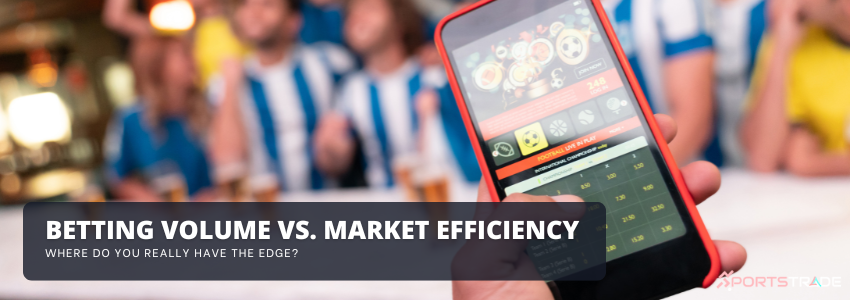Betting Volume vs. Market Efficiency: Where Do You Really Have the Edge?
- April 07, 2025, by Arnaldo Brito

Betting Volume vs. Market Efficiency: Where Do You Really Have the Edge?
In sports trading, traders are often torn between two types of markets: high-volume markets that are efficient and tough to beat, and low-volume markets that are less efficient but riskier. So where should you focus your energy? Understanding the relationship between betting volume and market efficiency is key to finding your trading edge.
1. What Is Betting Volume?
Betting volume refers to the total amount of money wagered on a particular event or market.
High-volume markets:
-
Premier League football matches
-
Grand Slam tennis finals
-
NFL games
Low-volume markets:
-
Lower-division football leagues
-
Niche sports (e.g., darts, futsal, eSports)
-
Early betting markets
More volume usually means more liquidity and tighter spreads—but also increased efficiency.
2. What Is Market Efficiency?
An efficient market is one where odds accurately reflect the true probabilities of outcomes. In efficient markets:
-
Odds are shaped by vast amounts of data and betting activity.
-
There's less room for error, making value harder to find.
-
Sharp traders and algorithms react quickly to new information.
This makes it difficult for casual traders to gain an edge—unless they have superior models or insights.
3. Pros and Cons of High-Volume, Efficient Markets
Pros:
- High liquidity = easier trade execution and less slippage
- More reliable odds and price stability
- Ideal for scalping and high-frequency trading
Cons:
- Less opportunity to find value due to high competition
- Odds are usually efficient by kickoff or tip-off
- Requires advanced models or insider-level insights
4. Pros and Cons of Low-Volume, Inefficient Markets
Pros:
- More frequent pricing errors and mispriced odds
- Easier to find value with basic analysis
- Opportunity to gain an edge using local knowledge or niche expertise
Cons:
- Lower liquidity can lead to price volatility and poor trade execution
- Higher spreads make it harder to profit consistently
- Easier for bookmakers to limit accounts in these markets
5. Where Do You Really Have the Edge?
It depends on your skill level, resources, and trading style.
Choose high-volume markets if:
-
You use data-driven models or trading software
-
You scalp or trade in-play for short-term swings
-
You value reliable execution over bigger edges
Choose low-volume markets if:
-
You have insider knowledge or deep sport-specific expertise
-
You prefer long-term, value-based strategies
-
You can tolerate wider spreads and more volatility
Pro Tip: Start with one market type, track performance, and expand into others as you gain experience.
Conclusion
Both high-volume and low-volume markets offer unique opportunities and challenges. The real edge comes from knowing where your strengths lie and matching them to the right type of market. Whether you're leveraging efficiency for precision or exploiting inefficiency for value, the key is strategy, discipline, and constant learning.
- Relegation
- Premier League
- Goal Scorers
- Womens Football
- Transfers
- Betting Guide
- Betting Help
- Betting Strategy
- Golden Boot
- Betting Odds
- Sports
- Betting Predictions
- Soccer Betting Tips
- Soccer News
- Betting Tipsters
- Sports Betting
- Soccer Betting
- Player Reviews
- Manager Reviews
- Match Previews
- Match Analysis
- League Reviews
- Club Reviews
- Betting System
- Sports Betting Tips Series
- Esports
- Casino
- Huddersfield Town
- Brighton & Hove Albion F.C
- English Premier League
- Relegation
- Premier League
- Goal Scorers
- Chelsea F.C
- Oliver Giroud
- Transfers
- Norwich City
- FA Cup classic
- Soccer Betting Tips
- Betting 101
- Basic Betting
- SportsTrade
- Golden Boot
- Betting Odds
- Manchester United
- Jose Mourinho
- Ed Woodward
- Boxing
- Rugby
- Sports Betting Tips Marketplace
- Arsenal F.C
- Sir Alex Ferguson
- Betting Method
- Professional Tipsters
- Betting Tips
- Online Sports Betting Tips
- Sports Prediction Tips
- Betting On Sports
- Betting Predictions
- Betting Experts
- Best Football Prediction
- EPL Betting Tips
- Soccer Tipsters Predictions
- Bet On Draw
- Betting Tipster
- Bet On Goal Scorers
- Soccer Tipsters
- Cristiano Ronaldo
- Eric Cantona
- Ryan Giggs
- Paul Scholes
- Peter Schmeichel
- Denis Irwin
- Gary Neville
- Rio Ferdinand
- Nemanja Vidic
- Roy Keane
- David Beckham
- Michael Carrick
- Park Ji-Sung
- Ruud van Nistelrooy
- Wayne Rooney
- Leicester City
- Newcastle United F.C
- Tottenham Hotspur F.C
- Liverpool FC
- Everton F.C
- AC Milan
- Stoke City
- Bull Taming
- Base Jumping
- Heli Skiing
- Harry Kane
- Mohamed Salah
- Sergio Aguero
- Pierre-Emerick Aubameyang
- Romelu Lukaku
- Claude Puel
- Manuel Pellegrini
- Javi Gracia
- Neil Warnock
- Chelsea F.C. Women
- Emma Hayes
- Wolverhampton Wanderers
- Cardiff City
- West Ham United
- Paul Pogba
- Philippe Coutinho
- Barcelona FC
- Alexis Sanchez
- Manchester City
- Money
- Juventus
- Champions League
- Real Madrid
- Neymar
- Hirving Lozano
- Paulo Dybala
- Kylian Mbappe
- Eden Hazard
- Birmingham City Ladies
- Bundesliga
- Bayern Munich
- Borussia Dortmund
- RB Leipzig
- Bayer Leverkusen
- La Liga
- Lionel Messi
- Luis Suarez
- Gareth Bale
- Andre Silva
- Antoine Griezmann
- Luca Modric
- Rapha?l Varane
- Womens Soccer
- Womens Football
- Timo Werner
- Top Scorer
- Robert Lewandowski
- Allison Plea
- Marco Reus
- Vedad Ibisevic
- Serie B
- Switzerland Super League
- Proposition Bets
- Fantasy Premier League
- Forex Trading
- Pep Guardiola
- Lucien Favre
- Thomas Tuchel
- Carlo Ancelotti
- Gareth Southgate
- Marco Silva
- Soccer Betting Market
- Cash Out Betting
- Accumulator Bets
- 1x2
- Total Goals
- Value Bet
- Soccer Betting Jargon
- Bookmaker
- Arbitrage
- Bankroll
- Parlay
- Point Spread
- Gianluigi Donnarumma
- Matthijs de Ligt
- Jadon Sancho
- Vinicius Junior
- Golden Boy
- Barcelona
- El Classico
- World Cup
- La Masia
- AFC Ajax
- Callum Wilson
- Raheem Sterling
- Marcos Alonso
- Andrew Robertson
- Rui Patricio
- Derby
- Manchester Derby
- Derbies
- Merseyside Derby
- Arbitrage Betting
- Betting Strategies
- Match fixing
- Legalisation
- FIFA
- Fernando Torres
- Andy Carroll
- Zlatan Ibrahimovic
- Asian Handicap
- Soccer Predictions
- Team Forms
- Ballon d??Or
- Luka Modric
- Stanley Matthews
- Hedge Betting
- Soccer Betting Lines
- Billy Walters
- KrackMan
- Labouchere
- Betting System
- Reverse Labouchere
- Sportsbook
- Bookies
- Peruvian Primera Division
- Alianza Lima
- Sporting Cristal
- Universitario
- Sport Huancayo
- KF Ferizaj
- Superleague of Kosovo
- Esiliiga
- Veikkausliiga Division
- IFK Mariehamn
- Oeste Futebol Clube
- Fluminense
- Flemingo
- Rot Weiss Ahlen
- Regionalliga
- Professional Punters
- D??Alembert
- Betting Theory
- Fractional Odds
- Decimal Odds
- Sports Betting Legalization
- Sports Betting
- Bitcoin
- Cryptocurrency
- Paroli formula
- Sports Betting Systems
- Positive Progression
- Negative Progression
- Martingale
- Regression analysis
- Fibonacci
- Dalembert strategy
- In-Play
- Goals Bracket
- soccer betting
- Draw Strategies
- Alisson Becker
- Jan Oblak
- Marc-André ter Stegen
- Ederson Santana
- André Onana
- Samir Handanovic
- Hugo Lloris
- Miralem Pjanic
- Kevin de Bruyne
- Christian Eriksen
- Bernardo Silva
- Frenkie de Jong
- Carlos Vela
- Germán Cano
- Abderazak Hamdallah
- Soccer Betting Algorithm
- basics of sports betting
- SMART
- Odds movements
- Vietnam
- Closing Odds
- Money Line
- Betting Line
- Handicap Betting
- Sports Betting In Thailand
- THBookie
- Singapore Pools
- Singapore Turf Club
- Maxbet
- Sbobet
- IMSports
- Sports Bookies
- Kelly Criterion
- Mathematical Method
- Mathematical Methods
- Copa MX
- Rayados de Monterrey
- Xolos de Tijuana
- Betting Strategy
- Betting market
- Double Chance
- Football Predictions
- Betting Forums
- Betting Probability
- Beat The Bookies
- Mathematical Analysis
- Athletic Bilbao
- Real Sociedad
- Copa Del Rey
- Granada
- Sevilla
- Covid-19
- Ekstraklasa
- Legia Warsaw
- Piast Gliwice
- Real Valladolid
- FC Basel
- Swiss Super League
- money management
- Emiliano Buendia
- Atletico de Madrid
- Raul Jimenez
- Adama Traoré
- UEFA Champions League
- Valencia
- Betting Tipsters
- Betting on eSports
- Gambling Industry
- Sportsbooks
- Casino games
- Casino
- Bruno Fernandes
- Jamie Vardy
- Value Betting
- Basketball Betting
- Tennis betting
- D'Alembert
- Fibonacci Succession
- Hits rate
- sports betting programs
- Bet Angel
- X-Bot
- Fairbot
- Sure Bet
- ROI
- Best Money Management Strategy
- Sports Betting Blogs
- Rescuebet
- Insiderbet.tips
- BettorClub
- Zidane
- Martin Odegaard
- Alvaro Odriozola
- EPL
- Transfers Windows
- Chelsea FC
- Takefusa Kubo
- Barcelona Soccer Camp
- Chelsea
- Frank Lampard
- Swansea City
- BTTS
- bankroll management
- Fractional Kelly Criterion
- Serie A
- Benevento
- Crotone
- Spezia
- Lecce
- CAF Champions League
- African Football Confederation
- Ansu Fati
- Roulette
- House Edge
- Poisson Distribution
- Exact Scores
- Ole Gunnar Solskjaer
- Harry Maguire
- Moneyline
- Predictions
- Inter milan
- Roma
- Italian Serie A
- Javier Pastore
- Sbotop
- Sbotop Magazine
- Leeds United Football Club
- Last-Minute Goals
- Value bets
- Todd Cantwell
- Prediction Models
- totalisator
- Tote
- Totalizer Betting
- Mutual Betting
- Joseph Oller
- Under 0.5 Goal
- UEFA
- Europa league
- CSKA Sofia
- Tottenham Hotspur
- Son Heung-Min
- Liverpool
- Jurgen Klopp
- poker
- Texas Holdem
- Omaha Poker
- 7 Card Stud Poker
- 5 Card Draw Poker
- Poker Player
- betting trends
- Profitable trends
- English Championship League
- EFL
- Sky BET Championship
- Krepen Diatta
- Transfermarkt
- Morgan Sanson
- Carlos Fernandez
- Kuaodio Koné
- Ajax
- Eredivisie
- J1 League
- Kawasaki Frontale
- Yokohama M
- AFC Champions League
- FC Barcelona
- Xavi Hernandez
- MLS
- LA Galaxy
- Diego Simeone
- Marcelo Bielsa
- Fibonacci Strategy
- Martingale Strategy
- Ormond betting system
- Bet365
- Blackjack
- New York City FC
- Simon Kjaer
- Fulham
- EFL Championship
- Championship League
- slot machines
- Casino Slots
- Slot Games
- PSG
- French Ligue 1
- Mauricio Pochettino
- Leo Messi
- Spartak Moscow
- CSKA Moscow
- Russian Premier League
- Fortnite
- Kyle Giersdorf
- Bugha
- Martin Satriano
- Nacional de Montevideo
- BTS
- Galatasaray
- Fenerbahce
- Turkish League
- Historic Football Rivalries
- AFC WC Qualifiers
- AFC
- Krakow Derby
- MKS Cracovia
- Wisla Krakow
- Polish Holy War
- Saint-Etienne
- French Ligue 2
- Automate Sports Betting
- Mason Mount
- Portsmouth
- Bonuses
- Betting bonuses
- Bettor
- Dynamo Dresden
- Free Agents
- Franck Kessié
- Marcelo Vieira
- Arturo Vidal
- Hamburger SV
- Werder Bremen
- Nordderby
- Goal Scorer Market
- Over/Under Betting Market
- Scoreline Betting
- Compare Odds
- Head-To-Head
- Losing Streak
- Positive Progressive Betting System
- Progressive Betting System
- Betting On Draw
- Mathematical Betting
- Progressive Betting Strategy
- 2014 World Cup
- 2010 World Cup
- 2006 World Cup
- 2018 World Cup
- Situational Trend
- Technical Trend
- Betting Data Trend
- Betting Bankroll
- Bankroll Management Systems
- Online Betting
- Malaysia Betting Market
- Bookie
- M8bet
- Mathematical Strategies
- Ladder
- Oscar Grind
- Forking
- Hedging
- Flat Betting
- Pre-Season Betting Strategy
- Matched Betting
- Sports Predictions
- Lay Betting
- Back Betting
- Bettors
- Science Betting
- Handicap
- Total Goal
- First Goalscorer
- Advanced Analytics
- Sports Analytics
- Player Valuations
- Spread Betting
- Risk Management
- Technical Analysis
- Live Betting
- Betting Exchange
- Correct Score
- Lay Bet
- Pandemic
- Esports Betting
- Counter-Strike
- Dota
- League of Legends
- Overwatch
- Legality Of Sports Betting
- Gambling Skills
- Betting Psychological
- Psychology Of Sports Predictions
- Statistics And Analytics
- Sports Prediction Model
- Probability Theory
- Line Shopping
- Betting Lines
- Spreads Betting
- Influence Of Weather
- Situational Trends
- PASPA
- Professional and Amateur Sports Protection Act
- Professional Tipster
- Tipster
- Odds Comparison
- Bookmakers
- European Soccer Leagues
- Value Of Trends
- Analyzing Team Form
- Long-Term Performance
- Short-Term Performance
- Transfer Window
- Future Bets
- Clean Sheet Betting
- Clean Sheet
- Betting On Clean Sheet
- Goals Conceded
- Man Marking
- Zone Marking
- Team Chemistry
- Tactical Adjustments
- Market Perception
- Betting Volume
- Legal Framework
- UK Gambling Commission
- Gambling Act
- Advanced Data Analytic
- Data Analytic
- Progressive Betting
- Losing Streaks
- Winning Streaks
- Blockchain
- Soccer Betting Algorithms
- Betting Algorithms
- Statistical Analysis
- Prediction Algorithms
- Early Betting Odds
- Closing Lines
- Betting Portfolio
- Managerial Changes
- Managerial History
- Betting Value
- In-Play Betting
- Pre-Match Bet
- Livestream
- Implied Volatility
- Sports Trading
- Ticks Technique
- Scratching Technique
- Scalping Strategies
- Green Up Technique
- Hedging Technique
- Data Analytics
- Sports Trader
- Sports Trading Union
- Risk Tolerance
- Coherence
- Coherence The Philosophical
- Sports Betting System
- Arsenal
- xG Statistic
- xG
- Expected Goals
- Mix Parlay
- Underdog
- Cashout
- 3-Way Handicap
- Situational Stats
- Football Betting Odds
- Decimal
- Paroli
- Statistical Models
- Data Analysis
- Betting Formula
- Liverpool Football Club
- Heysel Stadium
- Luton Town
- Oxford United
- Patrick Vieira
- Gianluca Zambrotta
- Bayern Munich Football Club
- Barcelona Football Club
- Cruyff Era
- Paris Saint Germain Football Club
- Paris Saint Germain
- Newcastle United Football Club
- Newcastle United
- Mike Ashley
- No Deposit Bonuses
- Cryptocurrency Betting
- Betting Marketing
- Sizing Strategies
- Statistical Software
- Betting Markets
- Sports Betting Odds
- Implied Probability
- Expected Value
- Wewin
- Market Trends
- Live Sports Trading
- Stop-Loss Strategy
- Winning Trades
- Live Data
- Liquidity
- Odds Movement
- Betting Data
- Betting Edge




